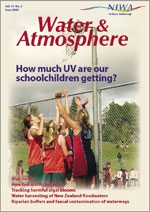01 June 2005
PDF of this article (62 KB)

One of NIWA’s aims with this magazine is to contribute to science education in New Zealand. To this end we distribute Water & Atmosphere without charge to New Zealand high schools. Most of the magazine’s articles are assigned ‘Curriculum Connections’ to indicate which of the NZ NCEA Achievement Standards they can complement as a classroom resource. These links are assigned by Royal Society of New Zealand Teacher Fellows who are working during the year with NIWA scientists.
Remember that there is an Archive of past issues beginning with September 2000 (vol. 8, no. 3). All online articles include a pdf of the printed version and the articles are indexed via the website’s search engine.
Curriculum connections for this issue
| Article | Relevant NCEA Achievement Standards | Brief summary |
|---|---|---|
| How much UV are New Zealand schoolchildren getting? | Biology 90714 (3.2) Science 90186 (1.1), 90313 (2.2) | Schoolchildren wore personal radiation monitors and kept activity diaries for a week in order to measure typical exposure to UV radiation. |
| Bubblegum corals from New Zealand seamounts and the deep sea | Biology 90462 (2.6), 90717 (3.5) | By studying the corals in the specimen collection at NIWA, the author identified eight new species that are unique to NZ waters. |
| Eye in the sky: tracking harmful algal blooms with satellite remote sensing | Biology 90164 (1.4), 90167 (1.7), 90716 (3.4) Science 90732 (3.6) | In 2002, harmful algal blooms around NZ were tracked from satellite images of sea-surface temperature and chlorophyll concentration. The algae in the blooms were also sampled from the water. |
| Breathing sediments: microbes, waves, and hidden animal pumps | Biology 90167 (1.7), 90461 (2.5), 90463 (2.7), 90716 (3.4) Science 90766 (2.8) | Recycling of organic material on the seabed depends on oxidation by bacteria. Pumping action by benthic animals helps drive the necessary oxygen diffusion through the seabed sediments. |
| Biological pumps: does the ocean inhale or exhale? | Biology 90167 (1.7), 90461 (2.5), 90716 (3.4) | Carbon is stored in the ocean when plankton die and drift to the seabed as ‘marine snow’. A biophysics project is investigating the rate at which this occurs in two different ocean climates in the waters off NZ. |
| In the poo: can riparian buffers reduce microbial contamination of waterways? | Biology 90168 (1.8), 90458 (2.2), 90483 (2.6) Geography 90207 (1.6), 90331 (2.1), 90336 (2.6) Science 90188 (1.3), 90313 (2.2) | Riparian buffers – planting strips along streams and rivers – are often recommended to improve water quality. This study examines how effective they are at stopping pathogenic microbes from washing in from pastures. |
| Reading between the lines: estimating rainfall for data-sparse catchments | Mathematics 90193 (1.5), 90641 (3.1) Science 90771 (2.2) | NZ’s rugged terrain can make it difficult to collect climate data, so scientists have devised ways to estimate the data for inaccessible areas. |
| Water harvesting: an ideal use of floodwaters? | Biology 90483 (2.9) Geography 90207 (1.6), 90331 (2.1), 90336 (2.6), 90701 (3.1) Science 90313 (2.2) | In some regions, floodwaters are stored for future use in agriculture. This article discusses where waters are being held in NZ and how this practice affects the river ecology downstream of the dams. |
